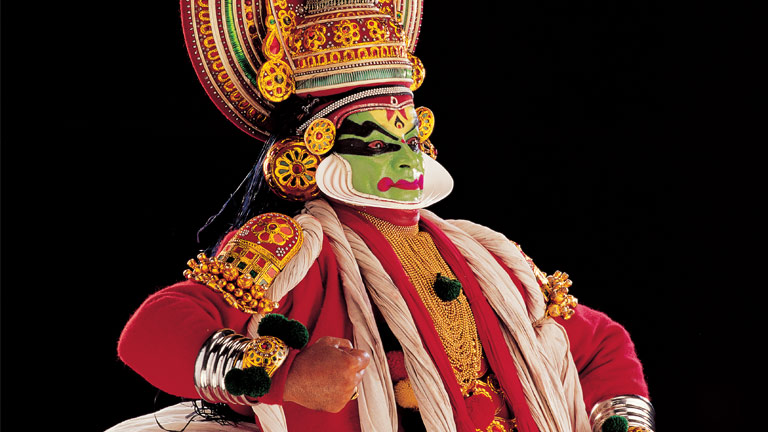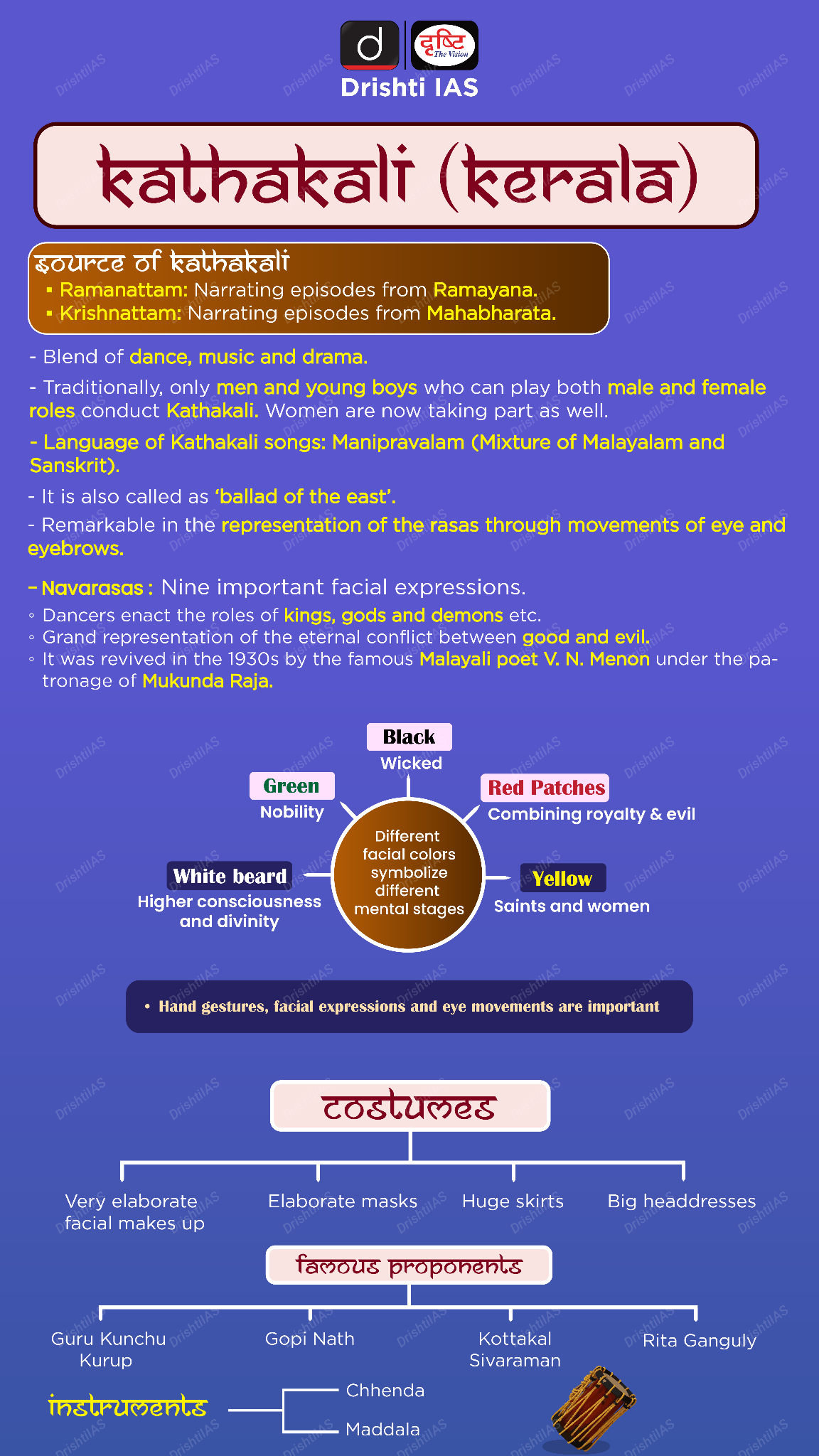Important Facts For Prelims
Kathakali
- 05 Jun 2023
- 6 min read
Why in News?
KK Gopalakrishnan has recently released a captivating book titled "Kathakali Dance Theatre: A Visual Narrative of Sacred Indian Mime."
- The book offers a behind-the-scenes look into the world of Kathakali, focusing on the green room, artists' struggles, and the unique bonds forged during long make-up hours.
What is Kathakali?
- Origin and History:
- Kathakali emerged in the 17th century in the kingdom of Travancore (present-day Kerala).
- The art form was initially performed in temple precincts and later gained popularity in the royal courts.
- Kathakali is based on Natya Shastra, the ancient treatise on dance, written by Sage Bharata.
- However, Kathakali relies on Hasthalakshana Deepika, another classical text for its hand gestures.
- Kathakali was in peril and on the verge of extinction in the beginning of 20th century.
- Renowned Poet Vallaththol Narayana Menon and Manakkulam Mukunda Raja took the initiative to set up Kerala Kalamandalam, a centre of excellence for classical art forms for the revival of kathakali.
- Kathakali emerged in the 17th century in the kingdom of Travancore (present-day Kerala).
- Dance and Music:
- Kathakali combines elements of dance, music, mime, and drama.
- The movements are highly stylized and include intricate footwork, rhythmic swaying, and various hand gestures called mudras.
- The dancers use their facial expressions, known as rasas, to convey emotions and tell stories.
- Manipravalam, a blend of Malayalam and Sanskrit, is the language used in Kathakali songs.
- The text of Kathakali songs is known as Attakkatha.
- Chenda, Maddalam, Chengila and Elaththalam are the major instruments used with Kathakali music.
- Makeup:
- Kathakali make-up is classified into five types according to the nature of the character.
- Pacha (green): noble and heroic characters, such as gods, kings and sages.
- Katti (knife): anti-heroes or villains with streaks of nobility or bravery
- Thadi (beard): different types of beards denote different types of characters, such as:
- Vella Thadi (white beard): divine or benevolent characters
- Chuvanna Thadi (red beard): evil or demonic characters
- Karutha Thadi (black beard): forest dwellers or hunters
- Kari (black): characters who are evil, cruel or grotesque, such as demons or witches.
- Minukku (radiant): characters who are gentle, virtuous or refined, such as women, sages or Brahmins.
- The costumes are colourful and extravagant, with heavy jewellery and headdresses.
- Kathakali make-up is classified into five types according to the nature of the character.
- Recent Developments:
- Inclusion of Women: Traditionally performed by male actors only, Kathakali has gradually opened up to female performers who have trained in this art form and taken up various roles.
- Innovation in Themes: Apart from the classical stories from Hindu epics and Puranas, Kathakali has also explored new themes from other sources such as Shakespearean plays, social issues, historical events and contemporary topics.
- Relevance of Kathakali in Today's Audience:
- Kathakali, being a complex art form, requires the audience to familiarise themselves with its gestural language, make-up codes, and stories to fully appreciate its depth.
- Furthermore, the introduction of modern technology, such as microphones and improved acoustics, has contributed to the renaissance of Kathakali music and its popularity.
UPSC Civil Services Examination, Previous Year Question (PYQ)
Q. With reference to the famous Sattriya dance, consider the following statements: (2014)
- Sattriya is a combination of music, dance and drama.
- It is a centuries-old living tradition of Vaishnavites of Assam.
- It is based on classical Ragas and Talas of devotional songs composed by Tulsidas, Kabir and Mirabai.
Which of the statements given above is/are correct?
(a) 1 only
(b) 1 and 2 only
(c) 2 and 3 only
(d) 1, 2 and 3
Ans: (b)
Exp:
- Sattriya is a classical dance of Assam, which comprises of dance-drama performances based on Ekasarana tradition (i.e., Krishna-centric Vaishnavism cult) which was organized by 15th century Bhakti saint Srimanta Sankardeva. Hence, statement 1 is correct.
- In 15th century, Sankardeva and his principle disciple Madhavdeva, systematized and directed the dance form using the ancient texts such as Natya Shastra (which embodies the Tandava dance and acting techniques), Bhagavata Purana and introduced drama and expressive dancing (Nritta and Nritya) as a form of a community religious art for emotional devotion to Krishna. Hence, statement 2 is correct.
- Further, the music is primarily based on Borgeets, composed by Srimanta Sankardeva and Madhavdeva in the 15th-16th centuries, which are a collection of lyrical songs that are set to specific Ragas but not necessarily to any Tala. Hence, statement 3 is not correct.
- Therefore, option (b) is the correct answer.







-min.jpg)